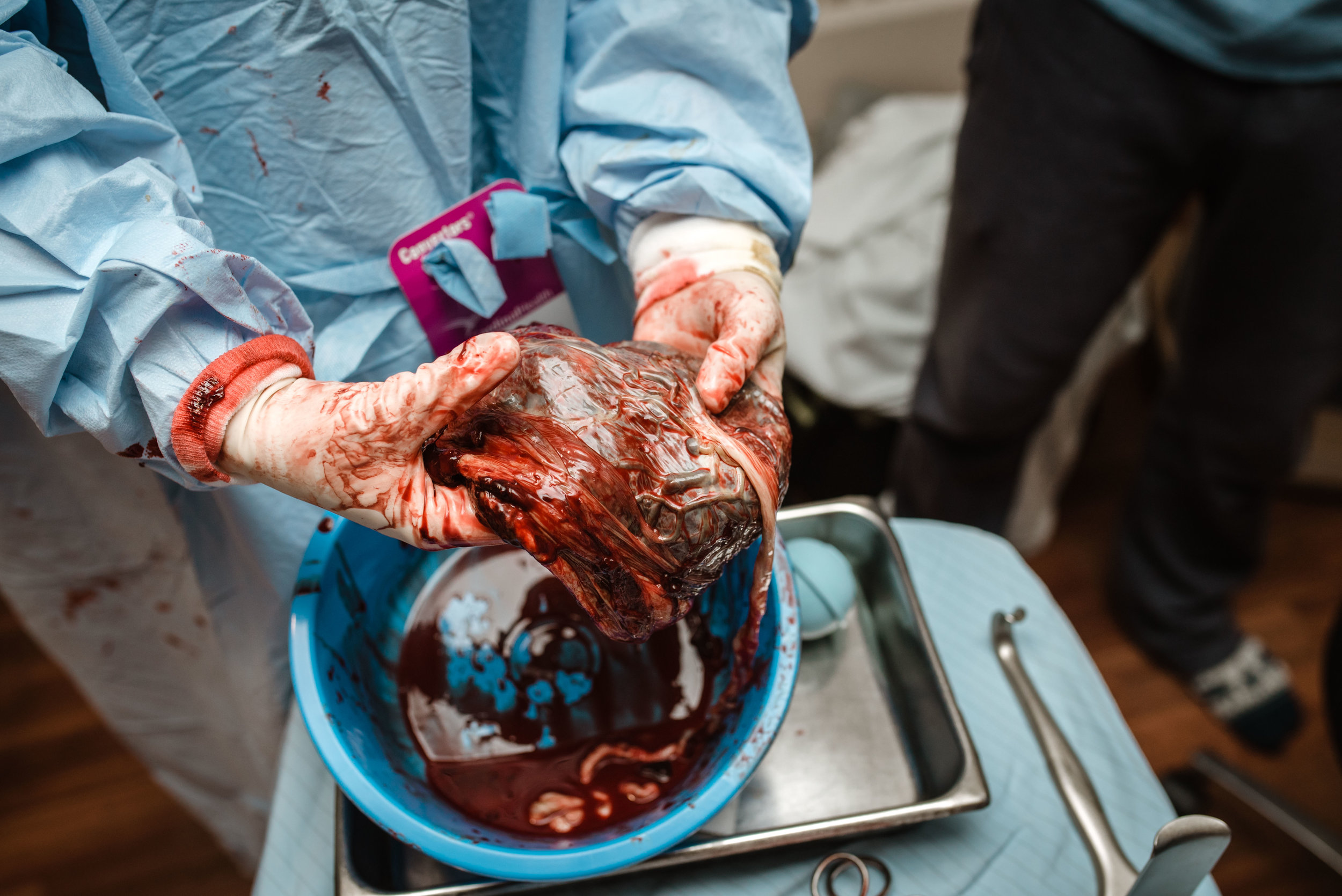The placenta is an incredible organ. I always try to capture at least one image of the placenta at each birth I attend. I find them to be fascinating, but for those who may not find them appealing, there are many reasons to respect them. Here are nine interesting facts you may not know about your baby's placenta.
a true knot in the cord
1. KNOTS ARE A VARIATION OF NORMAL
Cords knots occur in less than 2% of pregnancies. Most are relatively loose and don’t present a problem. Many times, the knots we see at birth were loose in the uterus and become tight through the delivery process. A substance called Wharton's jelly provides cushioning around the important blood vessels of the cord and protects them even if the cord gets knotted. As long as the knot remains loose, it won't cause harm to your baby. If the knot becomes tight, it could interfere with the circulation of blood from the placenta to the baby and cause oxygen deprivation. Such a complication is most likely to occur during your baby's descent through the birth canal, but these cases are rare. More common than knots are nuchal cords, the technical term for when the cord wraps around a baby's neck. Nuchal cords occur in as many as a quarter of all pregnancies and rarely pose risks to the baby.
the mother’s side of the placenta. this is the side that was attached to the uterus
2. LAYING LOW AFTER GOING THROUGH LABOR AND DELIVERY IS ESSENTIAL…
in part, because the wound the placenta leaves inside the uterus needs time to heal. Allowing yourself to rest and recover with the support of family and friends in the first four to six weeks after delivering your baby will set both you and baby up for better health in the long run. To learn more about this, please read The First Forty Days and The Fourth Trimester. “As modern mothers are pushed to prematurely ‘bounce back’ after delivering their babies, and are often left alone to face the physical and emotional challenges of this radically new chapter of their lives, The First Forty Days stands as a lifeline—a source of connection, nourishment, and guidance. It is the perfect ally for the first few weeks with a new baby…and beyond.”
3. THE PLACENTA ACTS AS YOUR BABY’S LUNGS
When you breathe, your body provides oxygen to your organs and tissues. During pregnancy, the pregnant person does the same thing for the fetus through the placenta. The oxygen passes through the placenta and the umbilical cord and is delivered into your baby’s bloodstream. The placenta also acts as your baby’s kidneys by filtering out waste. As baby is born, their lungs quickly adapt to life on the outside. Leaving the cord attached for a few minutes after birth (wait for white!), known as delayed cord clamping, helps them go through this process smoothly. (Evidence)
4. THE PLACENTA CAN PROVIDE IMMUNITY TO BABY AFTER BIRTH
During pregnancy, the placenta transfers antibodies that provide immune protection from the mother to the fetus. These antibodies provide three to six months of immunity for the baby after it is born.
a gush of blood lets you know that your placenta has started to detach
5. THE PLACENTA BENEFITS THE MATERNAL BODY AS WELL AS THE FETAL BODY
Fetal cells can transfer to the mother during pregnancy, and they seem to target sites of injury. These cells have been found in the skin, liver, kidney and bone marrow in healthy women as well as women with autoimmune diseases. They have also been found in women with diseases like hepatitis C and cervical cancer. There is evidence that the presence of these cells is increased in diseased tissues. The placenta also creates cells to protect the mother’s heart and fend off breast cancer.
the membranes, or amniotic sac, are hanging off of this placenta. baby was born en caul
6. WHEN THE PLACENTA IS BIRTHED, MILK PRODUCTION BEGINS
While it isn’t the placenta itself creating a new mother’s breast milk, it does have a role. When the placenta has separated, it triggers the production of prolactin. Prolactin is a hormone responsible for milk production. Once your milk comes in, it is produced on a supply and demand basis. The more often the milk is removed from your breasts (by baby or breast pump), the more milk your breasts will produce.
a unique cord insertion
7. THE PLACENTA IS PART OF THE EGG AND THE SPERM
When a sperm fertilizes the egg, the cells begin to quickly multiply. The egg and sperm become a blastocyst. The blastocyst becomes the placenta and the baby. Not only does the placenta belong to the baby and it’s mama, it also contains genetics from the father!
extended delayed cord clamping
we can see the cord, the baby’s side of the placenta, and the membranes which held the baby
9. THE BIRTH OF THE PLACENTA IS KNOW AS THE THIRD STAGE OF LABOR
After you give birth, you'll continue to have mild contractions. Your health care provider might give you a medication called Pitocin to reduce postpartum bleeding (here’s the evidence on that). Your provider might also massage your lower abdomen to encourage your uterus to contract and expel the placenta. This is called a fundal massage and many people find it to be incredibly unpleasant. You might be asked to push one more time to deliver the placenta. If you have a C-section, your surgeon will remove the placenta from your uterus during the procedure. Your provider will examine the placenta to make sure it it is intact. Remaining fragments must be removed to prevent bleeding and infection.
another true knot










